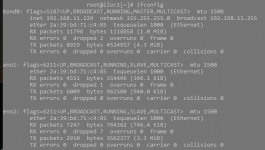danb35
Hall of Famer
- Joined
- Aug 16, 2011
- Messages
- 15,504
Apparently I need someone to break it down Barney-style for me, because I'm just not able to make this work. I'm wanting to set up both ports on my Chelsio T420-SO-CR NIC as a LAGG interface under SCALE 22.02.4. This was working under CORE 12 with exactly the same hardware (OK, with the exception of the boot SSD), but stopped working when I upgraded to SCALE. I reconfigured one of the ports on the NIC as its own interface, gave it a static IP (once someone else pointed out that "aliases" was the way to do that--hardly intuitive), and it's been working since then, but I'd like to get the LAGG back.
My switch is a Brocade ICX-6610-48P. It's running the latest firmware, and has LAGG configured on two ports--this configuration hasn't been touched since it was working with CORE:
So using the console menu, I choose option 1, configure network interfaces. In the menu that comes up, I delete enp130s0f4. Then I create a new interface of type LACP, name bond0, protocol LAGG, ports enp130s0f4 and enp130s0f4d1. Then I edit that interface and assign it an "alias" of the CIDR IP that had previously been assigned to enp130s0f4 (192.168.1.10/24). Then I apply the settings, and plug both ports from the NIC into the two designated ports on my switch.
At this point, it should work, right? I should be able to ping 192.168.1.10 from other hosts on my LAN, and ping them from the NAS. But no dice; I get timeouts. And yes, I have a default gateway (and DNS server, though it shouldn't be relevant here) set under Network -> Global. Surely I'm missing something simple here--any ideas?
My switch is a Brocade ICX-6610-48P. It's running the latest firmware, and has LAGG configured on two ports--this configuration hasn't been touched since it was working with CORE:
Code:
lag TrueNAS dynamic id 1 ports ethernet 1/3/7 to 1/3/8 primary-port 1/3/7 deploy
So using the console menu, I choose option 1, configure network interfaces. In the menu that comes up, I delete enp130s0f4. Then I create a new interface of type LACP, name bond0, protocol LAGG, ports enp130s0f4 and enp130s0f4d1. Then I edit that interface and assign it an "alias" of the CIDR IP that had previously been assigned to enp130s0f4 (192.168.1.10/24). Then I apply the settings, and plug both ports from the NIC into the two designated ports on my switch.
At this point, it should work, right? I should be able to ping 192.168.1.10 from other hosts on my LAN, and ping them from the NAS. But no dice; I get timeouts. And yes, I have a default gateway (and DNS server, though it shouldn't be relevant here) set under Network -> Global. Surely I'm missing something simple here--any ideas?


